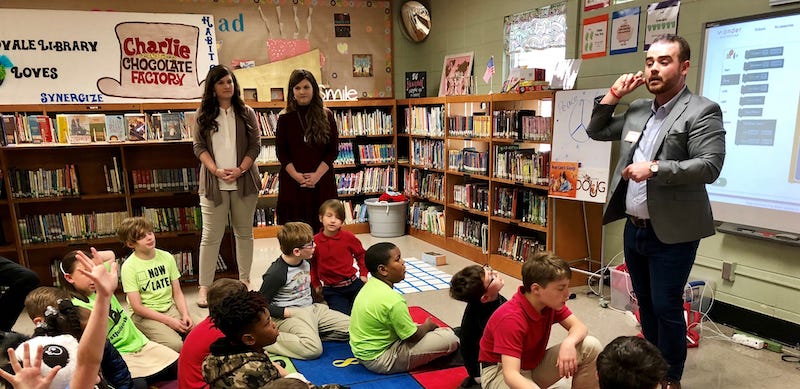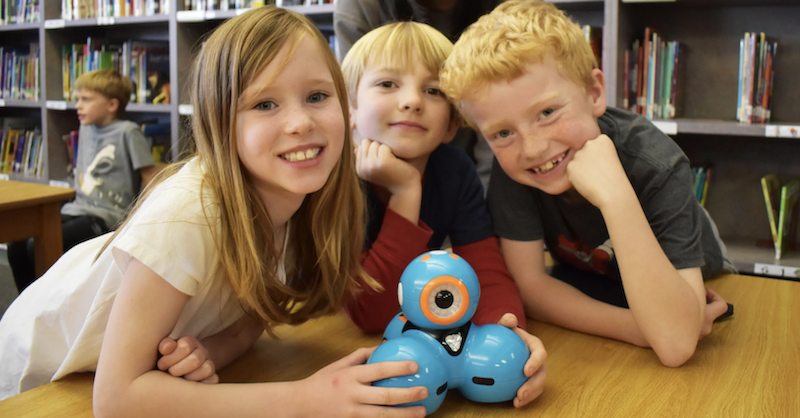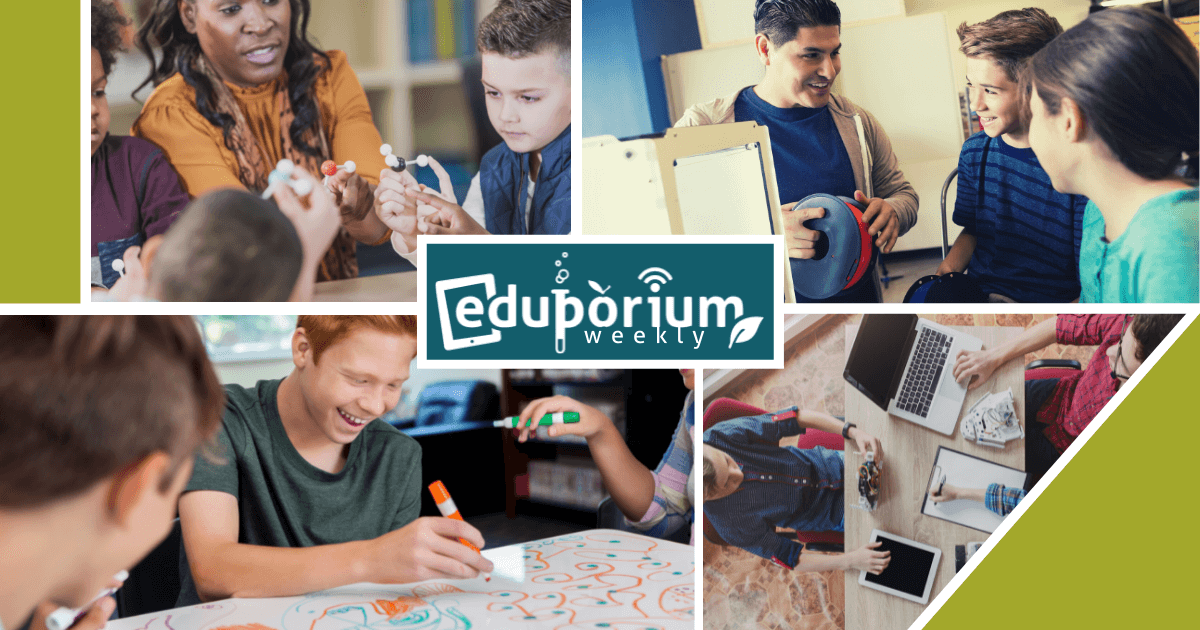As they continue to evolve in 21st century schools, libraries commonly feature exciting equipment to better serve and inspire students. As a result of the information revolution coupled with the impact of the Maker Movement, they now serve as everything from instant information hubs, innovation centers, and makerspaces in 21st century learning. Of course, they haven't always been like that, but our world has necessitated some changes resulting in revamped ways of educating students. So, let's look at the value in having an up-to-date school library space where students can do more than read.
Designing School Libraries to Ignite STEM Inspiration
School leaders are aware of the need to revamp certain learning experiences for their students. The world we live in today demands that they're problem solvers, understand technology, and are driven to access their creativity. Unfortunately, they can’t always get these experiences in a traditional classroom setting because of instructional requirements. To provide students with these experiences, many educators have turned to makerspaces, which allow kids to work with their hands, collaborate, get to know various technologies, and explore innovative solutions. The problem is that there is not always an obvious area to create a makerspace in every school. Either by choice or with no other option, school leaders continue turning to libraries as that location for innovative learning.
We know that libraries are filled with books, but more and more now house STEM opportunities that extend the classroom. The presence of more STEM programs in school libraries is certainly a step in the right direction when it comes to bolstering 21st century learning experiences and engaging students in productive learning. Any library with accommodating STEM resources is very valuable for inquisitive children. K-12 leaders are even going out of their way to be sure that library innovation is a part of their strategic plans when determining curricula, requirements, and plans for the school year. Teachers and librarians often hear stories of what others are doing in their libraries and continue to see the need to create spaces where their students are free to enjoy the same experiences.
Since educators are required to teach certain things, students don't always get to experience other important STEM challenges. Fortunately, school librarians can help create a space where kids can enjoy these added opportunities. Conveniently, they supplement the curriculum with learning that’s designed for the real world. Since libraries generally serve as a place with a variety of activities for students, adding STEM options for them is a common approach that works fairly well. Whether librarians want to dive right in and teach kids about 3D printing or start smaller with beginner-level robotics, there are so many possibilities. Thus, the value of trying something new shouldn't be understated—just like school libraries shouldn't be solely for reading.
Possibilities for Boosting Student Engagement in the Library
Aside from the MakerEd opportunities students can find in today's libraries, just about everything in these spaces can be digitized. Remember the old-fashioned card catalogs with drawers for each letter of the alphabet invented by Dewey Decimal? Well, it’s fun to reminisce, but even library reference systems have improved with technology. It's not surprising, but it's just another reminder of how technology can replace almost anything. And, while we're on the subject of libraries, that includes books. But, since libraries have become interactive learning hubs in many schools, there are a number of ways school librarians can utilize technology to better serve, engage, and excite their students.
One of the best ways to leverage technology in the library is with the equipment that’s already there. Many students learn better when they can visualize concepts or have access to images that supplement what teachers are saying. These days, videos are replacing images and, with computers and laptops flooding school libraries, students can easily pull up materials to help them. Since libraries are generally larger, more open spaces, librarians can also involve classroom teachers. Bringing learning from the classroom to the library, where students can collaborate, conduct more research, and access many resources is very helpful. It also works great with pretty much any subject in the curriculum.
Another advantage library learning provides for students is the opportunity for more mobile experiences. Most EdTech tools, like robotics and coding kits, are very much portable while remaining impactful. Students can bring tech tools to the library from the classroom without much hassle at all. Or, with the addition of one storage cart, the library could also become a storage center for school STEM tools since students will probably wind up doing a lot of interactive learning on tables or the floor. Finally, other educators have great ideas, too, so don’t be afraid to draw on them for inspiration and support. Chances are they have used some of the same STEM and MakerEd tools and can offer guidance and inspiration for how students can maximize their time in the library.

Transforming School Libraries with Purpose
Libraries are traditionally considered to be quiet environments where people go to read or do research. Of course, this is true for both public and school libraries. We talk all the time, however, about student collaboration and how active communication is good for innovative problem solving. Especially when you bring the term ‘makerspace’ into play, it may confuse some educators as to why they should want this type of environment in their library. After all, makerspaces are often messy and routinely chaotic, which is not consistent with a library environment. Today, however, students need to develop literacies that are slightly different than what we might traditionally push. They need invention literacy, coding literacy, and engineering literacy, all of which they can develop in a makerspace.
Despite the concrete traditions of school libraries, teachers must realize that student needs have changed. This requires making updates in libraries with librarians and school leaders leading the charge. A library needs to remain relevant so that students are able to make it a part of their learning experiences. One of its most important features is open access, meaning that all students have access to innovative equipment. Setting up a makerspace within a school library is a great way to enable this. Since the library is often where students go to conduct research, it’s the perfect spot for a school makerspace. Getting hands-on with some active research is generally a lot more beneficial for students and leads to much deeper engagement than they might get in the classroom.
Updating school libraries with makerspace tools makes them more relevant for students, but doesn't have to be a full transformation. This also helps educators because librarians would then be better able to serve the needs of an increasingly diverse student body with kids that learn in many different ways. Sometimes, the same old thing in the school library can, unfortunately, get boring for students. With a library makerspace in their school, however, it would be nearly impossible to replicate experiences from day to day. Above all else, makerspaces help promote brave creativity in students. With a little research and a willingness to shift the landscape of the school library, educators can bring a maker mindset into their schools in a room that’s already serving a purpose.
Tips for Bringing the Maker Movement to Your Library
The idea of making to learn or working with your hands goes back well over 100 years. In this day and age, we hear more and more about teachers abandoning a teacher-centered classroom and letting their students lead their own learning through maker-based challenges and activities. The Maker Movement certainly has impacted K-12 education and boomed in the last five years or so. When students have something to do rather than something to learn, they start thinking and really start learning. Of course, this has revamped student interest in learning and led to greater levels of achievement, but teachers need a place for maker learning to happen. Since we've been talking about libraries this whole time, you can probably guess where it most frequently takes place.
Maker education has become such a large part of K-12 libraries that many librarians have been recast as innovation directors or makerspace leaders. Now tasked with encouraging students to engage in tactile learning with various tools, they’re enabling discovery in entirely new ways. When students get hands-on with their learning, a lot of them begin discovering things they otherwise would have never realized. Since technology has advanced and become more accessible, students can also use tablets and other devices to enhance making. Even learning about robotics and coding comes with a maker component since students often build the robots themselves. Plus, the affordability of 3D printers opens up even more doors for making in the library.
As students get older, they can even take classes in the makerspace rather than just using the tools for open-ended invention. Depending on the equipment available, the best makerspaces might include 3D printers, CNC machines, laser printers, robotics tools, and some coding and engineering tools as well. Making sure there’s something for everybody is a top priority for librarians-turned-makerspace-leaders. This, as you might have guessed, is because inclusion is key in welcoming students into this environment. One final thing to remember is that educators can set libraries up to be conducive to collaboration. Whether tables are arranged in groups or in one large circle, many factors can encourage and increase student collaboration. And, overall, MakerEd tends to help librarians provide great 21st century learning experiences for students.

Adding Robotics to the School Library
We’re clearly advocates of using school libraries more as innovation centers, including to engage students in making, inventing, and tinkering. One other 21st century educational movement that’s popular in libraries is the use of robotics tools. Robotics education allows students to develop some true real-world skills, including coding, computational thinking, and problem solving. As school library experiences continue to evolve, many students find robotics at the forefront of their hands-on activities. Placing robotics tools in a library is a great way to showcase the variety of creative experiences students can have in that library environment and get them trying new things in a safe space. The extra floor space and availability of devices help make this a very real and popular possibility in many schools.
The beauty of robotics tools is that, while many are for educational use, they fit right into libraries as well. They offer another possibility for librarians to bring the community together through various events, competitions, and informational sessions. Of course, kids will probably be among the most interested and that’s perfectly fine. Robotics challenges can help them work together with peers and they benefit from robotics-based lessons in a number of ways. When possible, we also love hearing about librarians extending the school day by offering weekly or monthly programs for kids to come code and experience working with these technology tools. It activates experiential learning and even incorporates experiences similar to those students would have in a school or community makerspace.
Before they became technology hubs and makerspaces, libraries were a place children would traditionally travel to for story time. Actually, this is still very much true—even with all the technology now floating around. In fact, the two can work hand in hand and provide yet another engaging experience for students. Using robotics tools, like the Ozobot Evo or the Dash Robot, kids can create characters, plots, and settings for their robots and then program their interactions as they move around. They could get their robots to solve a problem, travel to a new destination, or find something they’d lost. Whatever they choose, they can tell stories in their own way and create programs to bring their robots to life.
For the latest EdTech, STEM, and 21st century education news, follow us on Twitter and Instagram. Like us on Facebook, too, or sign up for our newsletter for our latest product announcements and offerings. If you have an idea for an Eduporium Weekly theme, send us a message on social media or comment below.




I am a school librarian. I am planning on doing an MPhil degree in Library science. However, I want to do my thesis on how to incorporate STEM and soft music in school libraries. What are your thoughts?